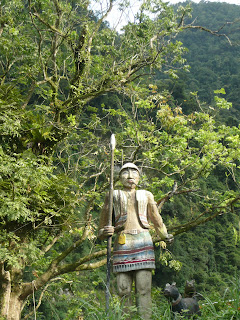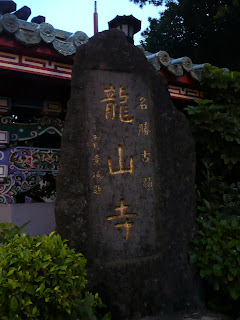This would only be my second half-marathon. Even though I was still running on a consistent basis, I really wasn't sure if I was ready to run 21km again. I got less excited when I found out that this would be the most attended road race event ever held in Taipei. If you know me, you know that I hate crowds. Whoever organized the event must be an amateur, because it does not make sense to have everyone running the full marathon, half-marathon, and the 9km (I don't even want to get into why it's 9km and not 10km) event all start at 7am sharp! Not to mention that there was some stupid 3km fun run that they were holding an hour later.
 It is too early!
It is too early! The always crowded transfer point
The always crowded transfer pointRace Day:
I woke up at 5am sharp, and was out the door at around 5:30am. The MRT opened early that day to accommodate racers. The race was to start near Taipei City Hall, which is pretty damn far from my house. My dad drove me to Chientan MRT station and my mom and I hopped on the train. It was already crazy crowded at Taipei Main Station when we go there to transfer to the blue line. We got to Taipei City Hall, and the number of people that were there was a really overwhelming. It took us forever to get to the bag drop-off place. And then I had to walk forever to get to the potty johns. It was closing in on 7am, and I was still in line! Thank you whoever invented the time chip!!! I decided to wait 10 minutes after the official start time to begin my run. It was still crowded and I couldn't see anything.
 The Taipei 101 at Sunrise
The Taipei 101 at Sunrise Jessie's stripping!
Jessie's stripping!I bolted when I crossed the time sensor, only to run into the sea of people. For the first 10km, I couldn't find a consistent pace because I still had people all around me. I nearly knocked people over several times, and was close to fall flat on my face!
I have to say though, running in the streets of Xinyi district in Taipei doesn't get boring at all. As I was running, there were big screen TVs showing news; there were shops along that I thought I should check out. I even ran past a few bakeries that seemed pretty tasty.
The routes finally split between the 9km group and the Marathon/Half-Marathon group. I finally had the space to find my rhythm. The run went really smoothly for me after that. At one point I started a little observation game to see what brand of running shoes other people had.
It got even less crowded when the marathon route veered off to another road. I think that's when I started really speeding up. I didn't even bother stopping for water or the ridiculous sponges that they were passing out. What was the point of passing out wet sponges?
There were a lot of cheer groups along the way. I tried to give all of them high-fives. It really helps just to have that extra motivation, especially towards the very end.
One of the most interesting parts of the run was when we intersected with the marathon runners, and I got to see the 1st place runner zoom right past me. It's one thing to see world class racers on TV and another to actually see one run past you.
There were 2 hills in the very last 3 kms. People started slowing down, but I wasn't gonna give in when I was so close to the finish line! I started going faster and faster, and when I saw the last km, I just sprinted, I didn't care how my legs were feeling. After I crossed the line I looked at my watch and it said 1:50 something. Wow, I had beat my last half-marathon by more than 5 minutes even with the heavy traffic in the beginning!!! I was so psyched, too bad there was no one there for me to share that feeling with right off the bat.
I got a box of food with my food ticket and ate a much needed banana and some sugary aloe drink. All I wanted though was water, but it was no where to be found...
I then got in line to get a message at one of the Nike tents. I waited about 20-30 minutes. It was worth it though, my legs really needed it.
I went to check the results afterwards, and I placed 13th in my age group! There was no ceremony for the age groups this time, but I did pick up a trophy and some useless prizes. But the best prize of the day was the runner high that I got for the rest of the day.
Next race? The K-Swiss 10km on February 17th!





























































